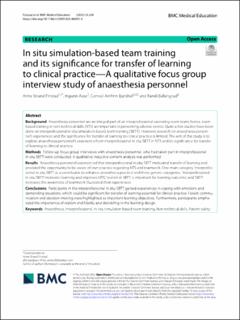| dc.contributor.author | Finstad, Anne Strand | |
| dc.contributor.author | Aase, Ingunn | |
| dc.contributor.author | Bjørshol, Conrad Arnfinn | |
| dc.contributor.author | Ballangrud, Randi | |
| dc.date.accessioned | 2023-08-23T09:27:06Z | |
| dc.date.available | 2023-08-23T09:27:06Z | |
| dc.date.created | 2023-04-20T13:23:42Z | |
| dc.date.issued | 2023-04 | |
| dc.identifier.citation | Finstad, A.S., Aase, I., BJørshol, C.A., Ballangrud, R. (2023) In situ simulation-based team training and its significance for transfer of learning to clinical practice-A qualitative focus group interview study of anaesthesia personnel. BMC Medical Education, 23 (1) | en_US |
| dc.identifier.issn | 1472-6920 | |
| dc.identifier.uri | https://hdl.handle.net/11250/3085389 | |
| dc.description.abstract | Background
Anaesthesia personnel are an integral part of an interprofessional operating room-team; hence, team-based training in non-technical skills (NTS) are important in preventing adverse events. Quite a few studies have been done on interprofessional in situ simulation-based team training (SBTT). However, research on anaesthesia personnel’s experiences and the significance for transfer of learning to clinical practice is limited. The aim of this study is to explore anaesthesia personnel’s experience from interprofessional in situ SBTT in NTS and its significance for transfer of learning to clinical practice.
Methods
Follow-up focus group interviews with anaesthesia personnel, who had taken part in interprofessional in situ SBTT were conducted. A qualitative inductive content analysis was performed.
Results
Anaesthesia personnel experienced that interprofessional in situ SBTT motivated transfer of learning and provided the opportunity to be aware of own practice regarding NTS and teamwork. One main category, ‘interprofessional in situ SBTT as a contributor to enhance anaesthesia practice’ and three generic categories, ‘interprofessional in situ SBTT motivates learning and improves NTS’, ‘realism in SBTT is important for learning outcome’, and ‘SBTT increases the awareness of teamwork’ illustrated their experiences.
Conclusions
Participants in the interprofessional in situ SBTT gained experiences in coping with emotions and demanding situations, which could be significant for transfer of learning essential for clinical practice. Herein communication and decision-making were highlighted as important learning objectives. Furthermore, participants emphasized the importance of realism and fidelity and debriefing in the learning design. | en_US |
| dc.language.iso | eng | en_US |
| dc.publisher | BioMed Central | en_US |
| dc.rights | Navngivelse 4.0 Internasjonal | * |
| dc.rights.uri | http://creativecommons.org/licenses/by/4.0/deed.no | * |
| dc.subject | simuleringsbasert trening | en_US |
| dc.subject | simuleringsbasert opplæring | en_US |
| dc.subject | anestesi | en_US |
| dc.title | In situ simulation-based team training and its significance for transfer of learning to clinical practice-A qualitative focus group interview study of anaesthesia personnel | en_US |
| dc.type | Peer reviewed | en_US |
| dc.type | Journal article | en_US |
| dc.description.version | publishedVersion | en_US |
| dc.rights.holder | © 2023 The Author(s). | en_US |
| dc.subject.nsi | VDP::Medisinske Fag: 700 | en_US |
| dc.source.volume | 23 | en_US |
| dc.source.journal | BMC Medical Education | en_US |
| dc.source.issue | 1 | en_US |
| dc.identifier.doi | 10.1186/s12909-023-04201-8 | |
| dc.identifier.cristin | 2142169 | |
| dc.source.articlenumber | 208 (2023) | en_US |
| cristin.ispublished | true | |
| cristin.fulltext | original | |
| cristin.qualitycode | 1 | |

